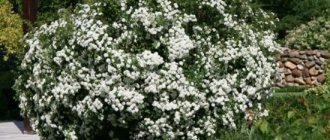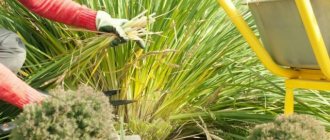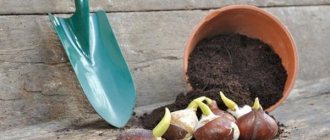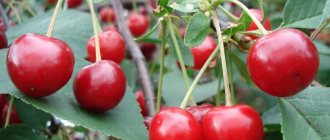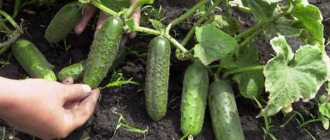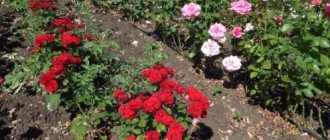You should not think that in the difficult Ural climate, a gardener’s flower “arsenal” is limited to unpretentious annual plants. When you want something more stable and durable, frost-resistant perennials come to the rescue.
One can only sympathize with the florist living beyond the Urals. Bringing beauty to a site located in a region with such a harsh climate is not just difficult, but extremely difficult... But absolutely possible! At first glance, the only way out of this situation may be to use unpretentious annual plants. However, among perennials there are enough species that cope well even with the Ural winter cold.
- USDA hardiness zones - what they are and how to use them here
Good for every gardener to know!
Siberian iris
i.etsystatic.com
One of the most hardy and frost-resistant perennials. The flowers of the Siberian iris are smaller than those of traditional species, but one bush can have up to forty flower stalks. It is curious that in some varieties the buds bloom almost simultaneously, in others - one after the other. In the first case, you get a bush abundantly strewn with flowers, and in the second, you achieve longer flowering.
- Iridarium - how to create a beautiful iris garden on your site
Irises in garden design can become the pride of the owner. How to create your own iridarium and care for it so that the charm lasts for months?
Features of perennials
There is an opinion that perennial crops do not bloom as brightly as annuals. In fact, you can find a lot of beautiful perennials that will surprise you with their beauty and unique flowering. Speaking about perennial plants, it is necessary to name a few more advantages:
- Perennial plants do not require replanting; they grow in one place for several years;
- Most species bloom throughout the season (all summer months);
- They are distinguished by good immunity to many diseases, are winter-hardy, tolerate drought well, and are undemanding in care;
- They do not require regular maintenance, all agricultural technology procedures are carried out as needed;
- They retain their decorative effect throughout the season, some remain green even under the snow;
- Economic benefit - any flower garden in the Urals made from perennials is much cheaper than the annual purchase of annual seeds.
On a note. By choosing the right perennial crops, you can create a beautiful flower bed that will delight you for several years.
Astilbe
Despite the fact that North America and East Asia are considered the birthplace of astilbe, this plant has taken root well not only in the gardens of the middle zone, but also in the flower beds of the Urals and Siberia. All thanks to the breeders who managed to develop ultra-winter-hardy varieties of this plant. Astilbe grows well in shaded areas and diffused sunlight. The main thing is to avoid overwatering, because stagnation of water threatens rotting of the roots during the season, and freezing in the winter.
In Canada, wild astilbe species are found in regions where the thermometer drops to -37°C in winter.
- Astilbe in open ground - planting and care calendar for each month
How to take care of astilbe all year round so that it will delight you with lush flowering.
Summer flowers
Although summer in the Urals is not too long, there are many plants that can bloom and please the eye even in such a cool climate. Next, we will get acquainted with the names and descriptions of these colors.
Daisies
Unpretentious cute flowers, with discreet, small buds. The flowering period of daisies is long and lasts all summer.
Lily
More often, two types are planted in the Urals:
Curly lily is an elegant small plant, reaching only 30 cm. Its bud has an unusual original shape, reminiscent of a fancy oriental turban. The color of the petals is delicate - white, pink.
The Pennsylvania lily is often found in our gardens. This is a well-known bright orange plant with a goblet-shaped bud. It can reach 1.2 meters in height.
Swimsuit
A plant listed in the Red Book, resembling a miniature rose. The swimmer likes to settle near bodies of water in nature, so take care of frequent watering and irrigation of the flower bed.
The buds are often yellow, less often orange. It begins to bloom in May, and the flowering period can last until mid-summer. Does well in the shade.
Arabis
A wonderful unpretentious ground cover with stems 20-30 cm tall. After planting, it quickly grows in the territory allotted to it, forming clumps strewn with small white and pinkish flowers.
Needs a haircut, which helps to maintain a decorative and neat appearance longer. It is better to plant it in an open area with loose soil. The culture is excellent for border decoration and alpine slides.
Doronicum
This plant blooms at the end of spring, but the main stage occurs in summer, sometimes even part of autumn is captured. Doronicum buds are yellow, large, and shaped like a chamomile. The stems are straight, can be either bare or with slight foliage. The plant reaches a height of 30-80 cm.
Doronicum is distinguished by its unpretentiousness and stability - what is needed for the Urals. Grows either in the sun or under sparse shade. Solid shadow is not suitable.
cornflower
At first, annual cornflowers were grown in gardens, but now gardeners are increasingly choosing perennial varieties. Cornflowers bloom all summer: from June to September, cute blue spots will be visible in your flowerbed. The foliage of this plant is also beautiful: bright and carved.
Cornflower is distinguished by its rare unpretentiousness; it endures winter, even the Ural winter, without shelter. It can grow quite happily both in the open sun and under the shade of trees and buildings. It is better, however, to choose partial shade: the flowering of cornflower will be brighter and more lush. The plant has no requirements for the composition of the soil.
Cornflower is a wonderful, friendly neighbor for most garden plants and can be part of a variety of flower arrangements. Today it is possible to choose not only flowers with standard blue petals, but also with white, pink, and lilac.
climbing rose
A very beautiful perennial, and the climbing rose has many varieties. The plant is climbing, the shoots reach five meters in length. In this case, not only the luxurious buds are beautiful, but also the bright foliage. The climbing rose blooms in the Urals in June and boasts small, but lush and brightly colored multiple buds.
Pansies
A cute low plant with bright flowers. This violet begins to bloom at the very beginning of the summer season and delights with its beauty almost until the end of the warm period.
Chrysanthemum
Chrysanthemum is the queen of the autumn garden. Gardeners love these perennials for their richness of shapes and colors. Only among the varieties of European selection, 10 classes of chrysanthemums are distinguished. Among them there are both flat and terry, and spherical, curly, anemone-shaped and other varieties.
Chrysanthemums with large flowers prefer warm climates, so there are practically no frost-resistant varieties among them. Korean chrysanthemums are grown in central Russia and more northern regions. This is not a separate botanical species, but a whole group of small-flowered varieties that are distinguished by their hardiness and frost resistance. Some of them can survive frosts down to –30-35°C without shelter. However, for the most part, flower growers prefer to play it safe and therefore additionally protect their plants from the cold.
Some varieties of chrysanthemums, for example, Orange Sunset, Chamomile and Lipstick, tolerate frosts down to –30°C well even in open ground. Others will need reliable frost protection.
- Chrysanthemums for the winter - proper care at the end of the season
Even this non-capricious plant needs help to prepare for winter - we’ll tell you how!
Agrotechnics of cultivation
Planting perennials
When planting perennials, it is worth considering that they grow over time. Therefore, they are placed at a distance from each other. In the first years, this distance can be filled with annual plants.
There are three options for planting perennial plants:
Each of them has its own characteristics. The timing of planting depends on the type of plant and the characteristics of cultivation in a particular case.
Over the years of growing perennial plants, certain rules and recommendations have developed. First of all, you need to observe all the features of planting and growing a particular crop. There are several nuances that need to be taken into account when creating decorative flower beds from perennials:
- When creating flower beds or alpine slides from plants of different heights, it is recommended to plant the tallest ones in the background, then those of medium height, and low-growing and ground-covering plants in the front.
- When planting, a small distance is maintained between perennials, as the plants grow quickly.
- Crops with different requirements should not be placed nearby, for example, plants that love moisture and require moderate watering.
- When planting plants, drainage is carried out for each crop, because few tolerate stagnant moisture.
Caring for perennials in the Urals
Caring for perennials in the Urals is not fundamentally different from other regions. To obtain beautiful flowering, you will need to carry out the whole complex of actions in accordance with the agricultural technology of the selected perennial crop; however, there are some nuances.
Watering is carried out in moderate volumes as the soil dries out. If the summer is dry, then the volume of water increases. After each watering, loosening and removal of weeds is carried out. Cleaning the root system of weeds is mandatory, as they are not afraid of winter and will gain strength faster than flowers in the spring.
Another important point is mulching. Straw, peat, and bark are used as mulch material, but the best option would be inorganic substances, for example, polyethylene film. It will also help preserve perennial flowers for the Urals in winter. It will not be superfluous to apply complex mineral fertilizers before winter.
All other agricultural technology activities are carried out in accordance with the requirements of the plant itself. Some require pruning in spring and autumn, others grow well without pruning.
Sheltering roses for the winter
Preparing for winter
Some plant varieties are not able to withstand the harsh winter of the Urals on their own. To prepare perennials, two stages of work are performed:
- Preparatory work. Plant stems are trimmed and dry leaves are removed.
- Shelter for the winter. Plant protection by covering is carried out in several stages. First, the root collar is protected. In such cases, you can use spandbond, lutrasil, agrofibre. Then the perennial itself is completely covered. Before constructing the second layer, a frame is made and the second layer is stretched over it. Double shelter is a prerequisite for the preservation of perennials from the frosts of the Urals. An improvised pillow is placed in the gap between the layers: dry leaves, preferably oak.
As you can see, it is possible to grow beautiful perennials in the harsh conditions of the Ural climate. With the right approach to creating flower beds, there will not be much difficulty.
It is important to choose the right varieties of garden flowers for the Urals and provide them with acceptable growing conditions
Adding an article to a new collection
You should not think that in the difficult Ural climate, a gardener’s flower arsenal is limited to unpretentious annual plants. When you want something more stable and durable, frost-resistant perennials come to the rescue.
One can only sympathize with the florist living beyond the Urals. Bringing beauty to a site located in a region with such a harsh climate is not just difficult, but extremely difficult... But absolutely possible! At first glance, the only way out of this situation may be to use unpretentious annual plants. However, among perennials there are enough species that cope well even with the Ural winter cold.
Hydrangea
Of all the types of hydrangeas, paniculate and tree-like ones feel best in cold climates. In general, caring for this crop in the northern region is not much different from growing techniques in the middle zone. However, there are some nuances, for example, it is better to plant a plant in spring rather than in autumn. Then the plant will have time to take root well and get stronger.
Hydrangeas love light, but do not respond very well to direct sunlight, so the most optimal place for growing this crop would be an area protected from the wind, located in partial shade, for example, along a blind fence.
Varieties that feel good in the northern regions are Pink Diamond, Limelight, Magical Flame, etc.
- Hydrangea - the main principles of cultivation
Do you grow hydrangeas correctly? Test yourself using our article.
Anemone (anemone)
Behind the fragile anemone inflorescences lies a truly steely character. Of the 170 species of this plant, 9 have permanent residence in the Arctic region (Alaska, northern regions of Russia, Canada, Norway). Rhizomatous small-flowered anemones are considered hardier than their large-flowered tuberous relatives.
If you want the plant to delight you with bright flowers, plant it in partial shade in neutral or slightly acidic soil. Avoid open areas - it has been observed that the petals of anemones growing in direct sunlight quickly discolor and fall off prematurely.
Peony
Large, fragrant peony flowers can radically transform the appearance of almost any garden. With proper care, these plants can grow in the same place for up to 20 years without losing their decorative qualities. They love well-drained loams and are completely unsuitable for growing in lowlands and other places with high humidity.
In order for peonies to delight with lush and bright buds, it is better to plant them in open areas away from trees and shrubs with a developed root system. An additional advantage of these beautifully flowering plants is their resistance to diseases and pests.
- What types of peonies are there: we understand the classification
Peonies are different: tree-like and herbaceous, double and non-double, early and late. Why do you need to know this?
Lilies
A whole group of lilies was bred for cultivation in the northern regions. The varieties and hybrid forms whose ancestors were lilies of the East Asian group are best suited for these purposes. When choosing a place to plant this ornamental crop, keep in mind that the lower part of the plant should be in the shade, and the upper part should be in the light. That is why lilies are planted between low perennials.
Some varieties of Asiatic lilies for the northern regions: Alaska and Snezhana - will delight you with large white flowers, Iskra and Nochka - red, Marle, Aphrodite and Fermata - pink, Sterntiger - orange, Fata Morgana and Solemio - yellow.
- Types and groups of garden lilies - description and photo
The classification of lilies will help you decide on the choice of type and variety.
Frost-resistant perennial flowers for short autumn, their name and photo
Autumn in the Urals is very short; the first snow may appear as early as September. But there are still crops that can please you with flowering during this period, namely:
- Perennial aster. The flower belongs to winter-hardy crops. The flowering period begins in July and ends with the first frost. It is advisable to constantly feed the plant for better development.
- Lupine. Hybrid varieties of this legume are used. The flower is not only a decorative decoration for your site, but is also used for medicinal purposes. It blooms twice a season: the first time in June, the second in September.
- Roses. The developed frost-resistant varieties tolerate northern conditions well (for example, floribunda or climbing rose). The plant needs regular pruning and additional insulation in winter.
- Korean chrysanthemums (selected varieties). Flowering: July – September. It is unpretentious in care, but winter shelter is a prerequisite for the survival of the flower.
Phloxes
These unpretentious perennials can decorate any flower garden. Among the rich variety of types of phlox, you can easily choose a variety to your liking. These unpretentious beauties have proven themselves well in the design of continuous flowering beds, mixborders and alpine slides. This is exactly the case when you won’t get away with planting a couple of specimens - phloxes look most impressive in masses.
This ornamental crop is undemanding to soil, but feels best in areas with loose and moist soil. In the harsh climate of Siberia and the Urals, with its cold but little snowy winters, it is better to plant phlox in areas that are illuminated and protected from the wind. In winter, plants are covered with peat, leaves or non-woven material.
- Popular types and varieties of perennial phlox
5 types and 21 varieties of phlox for every taste.
The best flowers for the Urals
Despite the harsh climatic conditions of the Urals, many flowers thrive in flower beds and delight their owners with beautiful blooms. Among the most popular and sought-after perennial flowers for the garden in the Urals, there are 10 most common ones.
There are many varieties of roses that can be grown in vegetable gardens and gardens in the Urals. They bloom longer than any perennial, but you should be prepared that they require much more attention than others. Until autumn, the Floribunda rose bushes will delight you with their flowering, which in appearance very much resemble double hips.
No less successfully, you can grow many varieties of hybrid tea roses, which are preferably planted one at a time. It is not recommended to place other flowers nearby, only ground covering plants.
Note! Many varieties of ground-blooded roses are suitable for climatic conditions and do not even need to be covered for the winter.
Peonies
A good option is to grow peonies. From the first year, this tall perennial produces beautiful blooms and does not require complex care. There are herbaceous and tree-like varieties of peonies. Each of them grows well in any soil. Double peonies delight in June with their beautiful flowers; non-double varieties can bloom in May.
Important! In the Urals, peonies should be covered for the winter, as the root system may freeze
Lupins
Very beautiful flowers that bloom twice a year: in spring and autumn. Like peonies, lupins have beautiful decorative leaves, so the plant is not cut off until autumn; it beautifully decorates the flower garden even without inflorescences.
Irises
More capricious, but no less beautiful are irises, which will delight you in the spring with their bright original inflorescences. This plant grows quickly and therefore requires frequent replanting. It is also worth remembering that this perennial crop will require regular peat moss - this is a way to protect the bulbs from the cold, as they are very close to the surface.
Chrysanthemums
This is another beautiful perennial that will bloom from early July to late autumn. To prevent the root system from freezing over the winter, you should cover the plantings with a wooden shield with gaps.
Chrysanthemum varieties with small flowers are very unpretentious; they are most often placed in the background of the flower bed. To prevent the branches from breaking from the wind, they are tied up. In autumn, the bushes are cut off almost at the root.
Kandyk Sibirsky
One of the bright primroses that emerges almost from under the snow. More common names are snowdrop or scilla. The shape of the flowers resembles small lilies. There are a wide variety of colors: white, yellow, purple, soft pink. Kandyk Siberian has a short height - up to 20 cm.
Important! The area where primroses are planted should be sunny and well ventilated
Muscari
Another of the earliest flowers that appear almost immediately after the snowdrop. The height of the stems does not exceed 40 cm. Mouse hyacinth blooms for about a month, from the beginning of May until the first days of summer. Muscari look most beautiful in group plantings. Propagation is done by bulbs.
Primrose
A low-growing, shade-loving plant that easily takes root in any conditions. In the gardens of the Urals, primroses will produce beautiful variegated flowers from May to June. Loves light, slightly moist soils. Doesn't like moisture getting on the leaves.
Important! To prevent primroses from freezing in cold winters, the plant should be covered. It will be enough to use dry leaves
Phloxes
Another option for low-growing crops that bloom throughout the summer. A wide selection of colors will allow you to create interesting compositions. Another advantage of this plant is its amazing aroma during flowering. The plant reaches up to 3 cm in height.
Lily
This is a win-win option for any personal plot. The plant is unpretentious, but at the same time it looks very elegant and beautiful. Grows well both in the sun and in the shade. Transplantation is carried out once every 4-5 years. Experts recommend creating compositions from several types of plants at once, this will help ensure that the flowerbed blooms all summer long.
The best perennial garden flowers for the Urals were listed; it is simply unrealistic to list all types, since, thanks to the fruitful work of breeders, today there is a million-dollar list of crops that grow well in this area.
Clematis
Despite the fact that not all varieties of this plant can be successfully grown in northern climates, the remaining frost-resistant varieties are more than enough to satisfy the needs of even the most demanding gardener. The main thing to consider when choosing clematis for your garden is the pruning group. In areas with cold climates, plants are grown that bloom on this year's shoots, i.e. perennials of the second and third groups.
- All about clematis: a complete guide to planting and care
A complete guide to planting and caring for clematis for those who have always wanted to grow these flowers, but for some reason were afraid of not being able to cope with them.
There are many more perennials that can be successfully grown in northern regions than meets the eye. Science does not stand still, and the more a gardener wants to grow some kind of “southern” crop on his plot, the more efforts breeders make to develop a frost-resistant variety.
Medium Height Plants
We will talk about flowering perennials that will allow you to diversify the color scheme of the natural landscape.
In cold climates, early varieties of tulips can be grown. For example, simple and double tulips, which in Siberia and the Urals can bloom at the end of May. But such plants need care: they should be dug up and dried annually to preserve the bulbs.
Frost-resistant and unpretentious varieties of iris can grow even up to 85 centimeters. Siberian Iris, blooming in a blue-blue palette, is suitable for Siberian and Ural gardens. This plant tolerates even severe frosts well. Also popular is the Bearded Iris variety, reminiscent of tropical epiphytes. It begins to bloom in early summer.
By the way, by combining different varieties of such plants, you can achieve bright and lush flowering throughout the summer season.
Another example of unpretentious perennial flowers for Siberia and the Urals is mountain cornflower. Throughout the summer season, flowers of a rich blue hue appear on it. Careful care for such plants is not required, as well as watering, as well as special transplants, characteristic of many other species. The height of mountain cornflower can be about 0.6 meters.
You can beautifully decorate your garden plots with the help of saranka or curly lily. The petals of such flowers look like an oriental turban. Most varieties have a pinkish tint, but others, such as orange, are also found. Such plants are especially in demand among gardeners, since they do not cause any difficulties when planting and growing.
If you're looking for plants that will attract attention in your garden, look no further than the Pennsylvania lily. This plant blooms during the summer and has large buds in red and orange hues.
We can also offer you to decorate the area with decorative onions. This perennial plant is not only characterized by its colorful appearance, but also has many health benefits. And thanks to its unpretentiousness and resistance to severe frosts, it will remain for subsequent years, so you can enjoy the benefits of growing this variety for a long time.
During the flowering period, charming inflorescences with flowers of lilac, lilac, snow-white, and violet appear on the decorative onions.
Yarrow is also popular in gardens created in the Urals and Siberia. To date, experts have developed many ornamental varieties of this plant, differing in appearance and flowering period.
To maintain the beauty of yarrow, you do not have to constantly water or replant the plant. But your garden will be decorated with lush inflorescences of various shades, from white to bright red.
Perennial flowers for the Urals, blooming all summer: photos and names
And the next plant will not only become a worthy decoration for your garden, but will also allow you to decorate unsightly areas. We are talking about a climbing rose: this perennial plant begins to bloom in early summer. Red, pink and snow-white buds will look great on any homemade hedge.
As for perennial plants with decorative leaves, they are most often used as a background in garden plots
Once the flowering season of most plants is over, these varieties will continue to attract attention with their greenery
For example, you can plant in the garden hostas with large lush leaves, bergenia, which has round oblong foliage and pink inflorescences, as well as liatris, which is characterized by thin, lush leaves of great height and upward inflorescences of delicate shades. Chrysanthemums, which bloom with lush buds during the flowering period, rudbeckias, reminiscent of yellow daisies with a dark center, and doronicums, which are small lush bushes of small yellow flowers, will also look charming.
Perennial flowers for Siberia: photos and names
